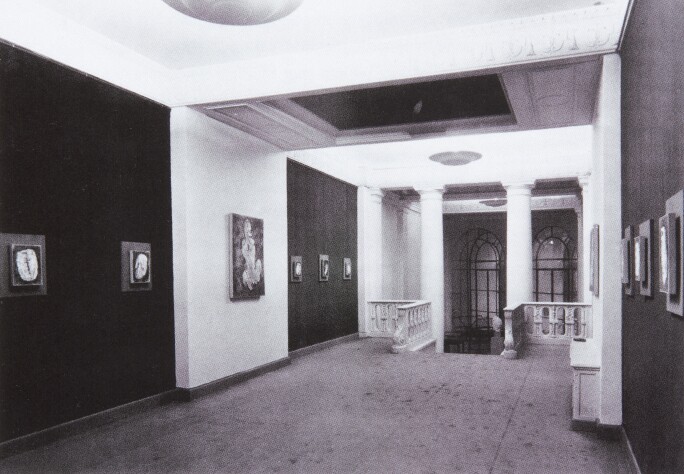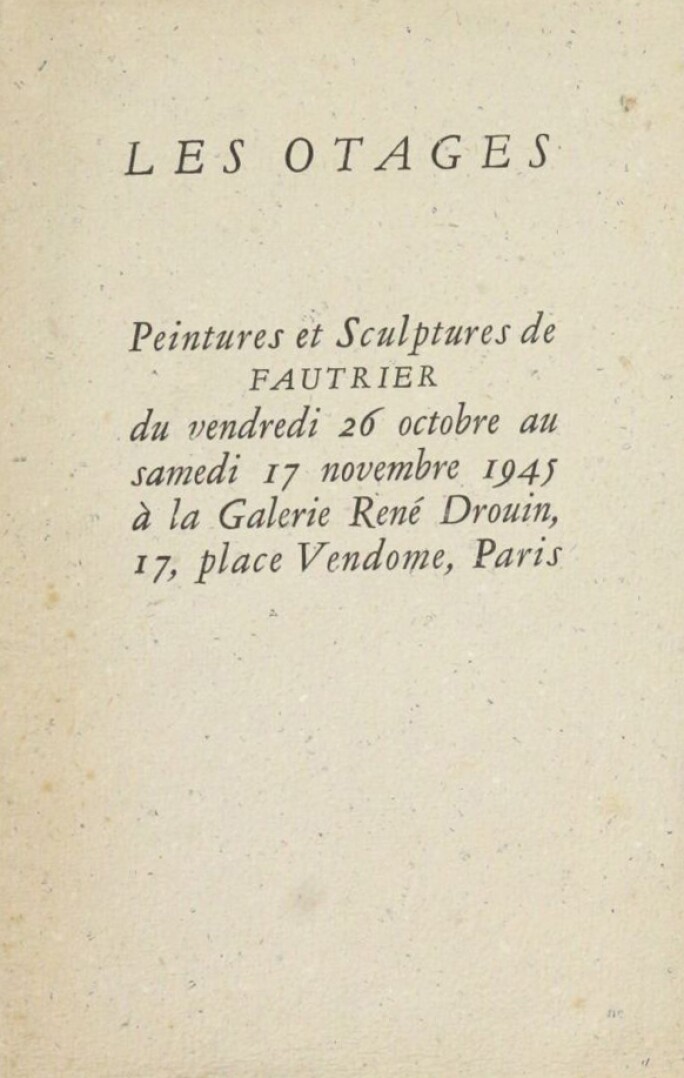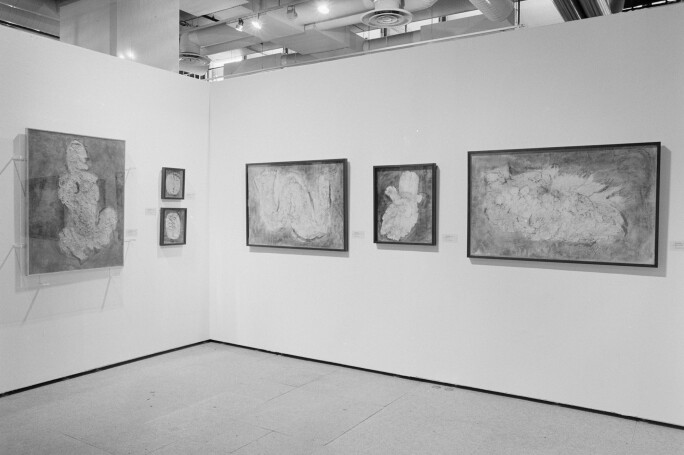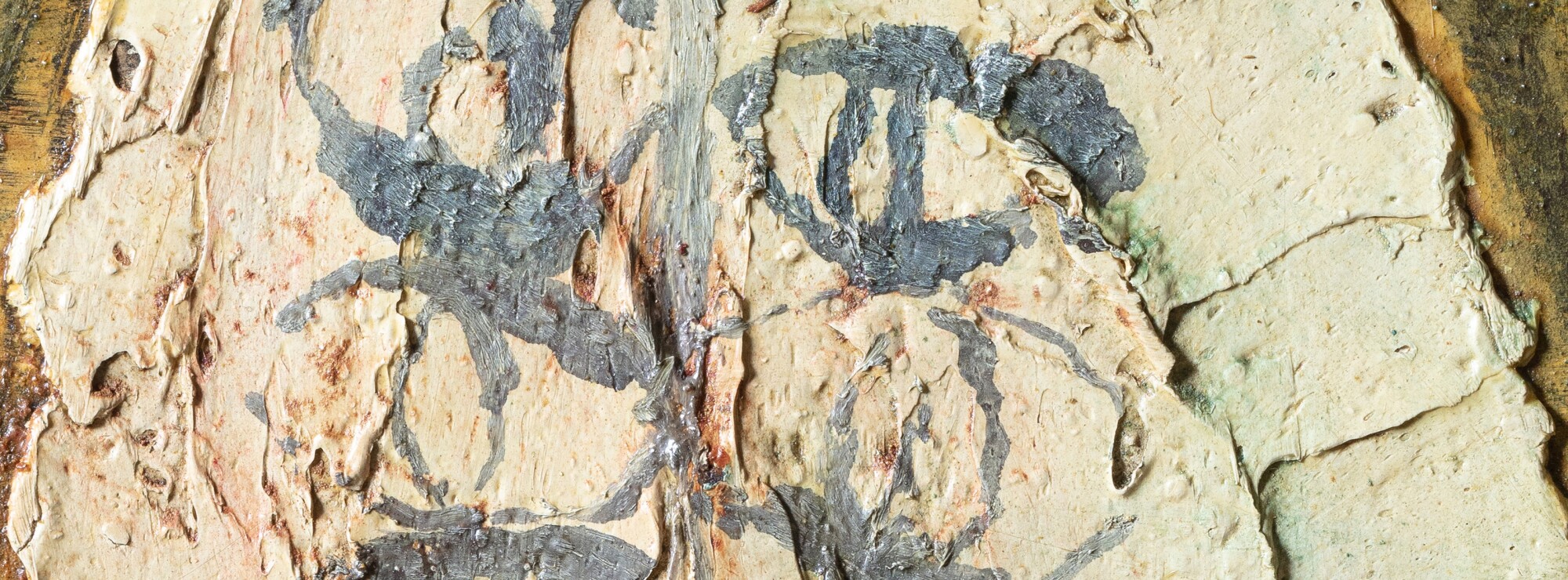
Image: © courtesy Musee de l' Abba ye Sainte-Croix
Artwork: © ADAGP, Paris and DACS, London 2021
Belonging to Jean Fautrier’s illustrious and haunting series Otages (Hostages), the present work debuted and Galerie Rene Drouin, Paris, in 1945. A stunning amalgamation of beauty and horror, Tête d'otage N. 15 epitomizes the height of Fautrier's career, as the artist himself noted in a letter in 1944: "It seems to me that the evolution has been insane and that I'm finally arriving at what I have always hoped" (J. Fautrier cited in: Exh. Cat., Milwaukee, The Patrick and Beatrice Haggerty Museum of Art; Jean Fautrier, 2002-03, p. 209). The only surviving photograph from the Drouin exhibition shows the Otages hung closely in long rows, a shocking installation highly suggestive of mass executions. The exhibition led to an overwhelmed and shocked public reaction, for the works embodied both the recognition and remembrance of suffering, while also standing as powerful images in their own right. Eight years after Picasso expressed the horror of martyred Spain in his revered epic Guernica, Fautrier’s Otages enlisted a serene and enigmatic aesthetic language to advance potent reflections on the worst atrocities of the Twentieth Century.

(centre) Jean Fautrier, Tete d'Otage no. 1, 1944, The Museum of Contemporary Art, Los Angeles, Image: © The Museum of Contemporary Art, Los Angeles, Artwork: © ADAGP, Paris and DACS, London 2021.
(right) Jean Fautrier, Tête d'otage n. 21, 1944-45, Centre Pompidou, Paris, Image: © Centre Pompidou, MNAM-CCI, Dist. RMN-Grand Palais / Philippe Migeat, Artwork: © ADAGP, Paris and DACS, London 2021.

Revolutionary in their pictorial technique, the Otages marked the inception of Art Informel and declared Fautrier as one of its leading figures. Strongly influenced by Art Brut, together with artists such as Jean Dubuffet and Wols, Fautrier pursued an improvisational approach, gestural abstraction and a technique freed from the conventions of classical painting that revolutionized the aesthetics of visual arts in Europe at this time. Indeed, the Otages series broke with tradition, as explained by legendary critic Michel Tapié: "It was in 1943, on seeing some new works by Fautrier, that I had the impression for the first time that there was something else... Two staggering shows marked in 1945 the beginning of that something else with which we are now beginning to feel at home, seeing in it inexhaustible suggestions for adventures in depth: I am referring to Jean Fautrier's Hostages and to Dubuffet's High Impastos" (Michel Tapié, Un Art Autre, 1956). Indeed, the visual languages of Fautrier and Dubuffet at the close of the Second World War were undeniably linked; both embodied Tapié’s ‘un art autre’ aesthetic via nontraditional techniques and materials, in turn confronting themes of ugliness and disfiguration, and exposing the darkest facets of the human condition. Fautrier’s Otages are similar to Dubuffet’s Mirobolus, Macadam & Cie paintings in their thick build-up of media and their inherent interrogation of conventional standards of beauty, standards traditionally epitomised by the belle peinture of the time. Both artists also sought to explore the tension between abstraction and figuration, manipulating and disfiguring the human body with unrelenting vigour.

Image: © Centre Georges Pompidou
Artwork: © ADAGP, Paris and DACS, London 2021


Musée du quai Branly, Paris
Image: © musée du quai Branly - Jacques Chirac, Dist. RMN-Grand Palais, photo Patrick Gries Patrick Gries/
Tête d'otage N. 15 exemplifies Fautrier’s innovative haute pâte technique. In the execution of the present work, he mounted and glued paper on a panel lying on his studio table, applying a thick ground layer to the paper to create a bas-relief. He then drew with gouache or ink and sprinkled pigment that would become absorbed into the thick wet impasto before finally varnishing the completed work. As observed by André Malraux: "the technique of his current pictures, which are very few in number, requires a rapid execution, and many of them seem to be lyrical improvisations but are the sudden fruits of a slow ripening, in the sense that modern poems are" (A. Malraux cited in: Exh. Cat., Milwaukee, The Patrick and Beatrice Haggerty Museum of Art (and travelling), Jean Fautrier, 2002-03, p. 190). Tête d'otage N. 15 is the culmination of this remarkable painterly method employed throughout the Otages series. Highly mnemonic of pain, suffering and harrowing mass executions, the present work is one artist’s cathartic answer to the unfathomable and ungraspable terror left behind in the wake of the Second World War.